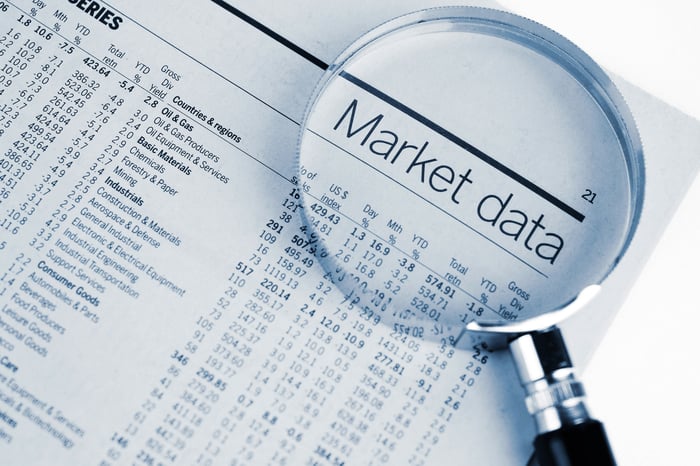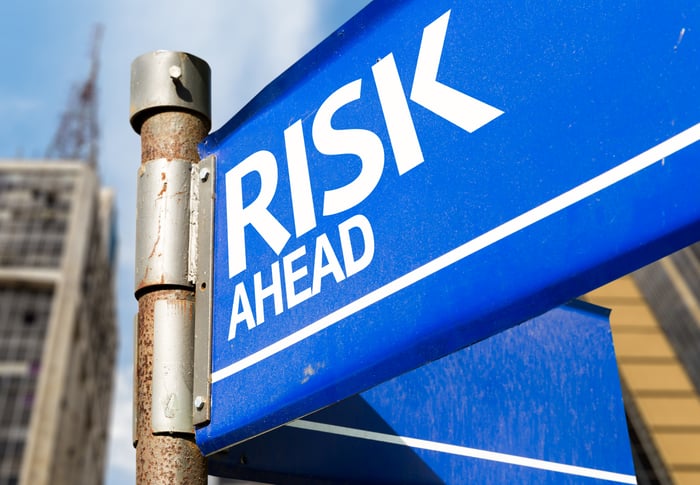One year ago today, March 23, 2020, all of the major U.S. stock indexes hit their bear market bottom.
From peak to trough, it took the benchmark S&P 500 (^GSPC -0.22%) just 33 calendar days to lose 34% of its value. For some context here, previous bear market declines of at least 30% in the S&P 500 took an average of 11 months to develop. The coronavirus disease 2019 (COVID-19) pandemic shaved off 30% from the widely followed index in a month.
But investors have also relished in a record-breaking bounce-back rally. The tech-heavy Nasdaq Composite (^IXIC -0.52%) more than doubled from its March 23 low, whereas the S&P 500 has rallied 77%.
However, if history proves accurate, this year will likely feature a sizable correction in the broader indexes ranging between 10% and 19.9%. Here are three reasons a stock market correction (or even crash) is likely in 2021.

Image source: Getty Images.
1. Corrections occur, on average, every 1.87 years
Let's begin with the basics: Stock market corrections are lot more common than you probably realize.
According to data from market analytics firm Yardeni Research, the S&P 500 has undergone 38 corrections since the beginning of 1950. That's an average of one decline of at least 10% every 1.87 years.
Admittedly, the stock market doesn't adhere to averages. For instance, between 1991 and 1996, there wasn't a single correction in the S&P 500 totaling 10% or greater. By comparison, there have been seven double-digit percentage declines in the S&P 500 since the beginning of 2010. It may be impossible to precisely predict when a correction will occur, but it's never too off-the-wall to imply that one is around the corner.

Image source: Getty Images.
2. A correction has been a given within three years of an S&P 500 bear-market bottom
History provides another clue that a correction is almost certainly coming.
Since 1960 (an arbitrary year I chose for simplicity), the S&P 500 has endured eight bear-market declines of at least 20%, not counting the recently ended coronavirus crash. In the three subsequent years following the bottom for each of these bear markets, or until another bear market arose, if less than three years passed, we witnessed a correction of at least 10% in the S&P 500. In fact, 13 aggregate corrections have occurred in the three-year period subsequent to the last eight bear-market bottoms.
In simpler terms, bouncing back from a bear market rarely means we go straight up. It's often a bumpy ride as the economy and new bull market find their legs.

Image source: Getty Images.
3. The Shiller P/E ratio sends an ominous warning
A valuation metric offers the third reason a correction is likely in 2021.
The Shiller S&P 500 price-to-earnings (P/E) ratio is a P/E ratio that's based on average inflation-adjusted earnings from the previous 10 years. Over the past 150 years, the average reading for the Shiller P/E is 16.8. As of this past weekend, the Shiller S&P 500 P/E ratio was 35.2 -- more than double the historic average.
In some respects, a higher Shiller P/E ratio is expected. Persistently low lending rates have fueled growth, and the advent of the internet a little over 25 years ago broke down barriers between Wall Street and Main Street that existed for more than 100 years.
However, history has been crystal clear that a Shiller P/E ratio above 30 is bad news. In the four previous instances where the Shiller S&P 500 P/E ratio crossed above and sustained the 30 level, the index subsequently lost between 20% and 89%. The good news I can offer is that an 89% decline (this occurred during Great Depression) is highly unlikely, thanks in part to a responsive Federal Reserve and federal government. But in every previous instance where stock valuations become historically stretched, a big correction soon followed.

Image source: Getty Images.
Buck-up, investors: Corrections are an opportunity to get rich
While this is probably not the news you want to hear after navigating your way through one of the steepest crashes in stock market history one year ago, it's also a heads-up that opportunity may be on the horizon.
You see, every single stock market crash or correction since the inception of the broad-market indexes has eventually been erased by a bull market rally. In many instances, it doesn't take all that long for a correction to find its bottom, or for the widely followed indexes to recoup their losses. Of those aforementioned 38 corrections or crashes in the S&P 500 since the beginning of 1950, 24 of them have found their bottom in 104 or fewer calendar days (about 3.5 months).
What's more, while corrections generally drag most stocks lower, this is a function of short-term emotions or panic and not something fundamental. In other words, corrections very rarely have a discernable impact on a company's operating model.
For instance, Amazon (AMZN -1.14%) has declined 13% since hitting its September high of $3,531 a share. If a correction were to occur and took Amazon's stock down a couple hundred dollars more, it isn't going to have any effect on the company itself. What it would do is make the company more fundamentally attractive to investors. As the leading e-commerce company (by a mile!) in the U.S., Amazon's shoppers would continue buying from its marketplace, and businesses would keep utilizing its cloud infrastructure services.
If a correction does occur in 2021, consider it your second opportunity in as many years to buy great companies at a discount.




